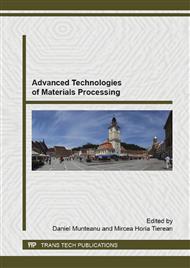p.322
p.332
p.338
p.347
p.353
p.364
p.372
p.378
p.384
Influence of Functional and Construction Parameters Over Sieving Process – Rotary Cylindrical Sieve
Abstract:
This paper studied functional parameters: the angle of the shaft section (feed flow rotor) and rotor speed which directly influences the yield of screening with three types of sand (NR1, NC2 and NT3). Experiments was determined following an increase of the values of the shaft angle makes sifting efficiency decrease; the greater the passage section of the material, so the feed rate of the rotor, the efficiency decreases; and a higher rotor speed makes sifting flow to increase with increasing speed. Based on experimental data it was obtained a program that is subject to problem solving regression analysis in which the efficiency is represented as a function of two dependent random variables (speed and angle tilt rotor shaft/rotor speed and power flow rotor/angle tilting spindle and feed rate). The test is a prediction of the values output in certain circumstances depending the two variables. With these predictions decisions can be made for the construction/purchase or for screening.
Info:
Periodical:
Pages:
353-363
Citation:
Online since:
October 2015
Authors:
Keywords:
Price:
Сopyright:
© 2015 Trans Tech Publications Ltd. All Rights Reserved
Share:
Citation:


